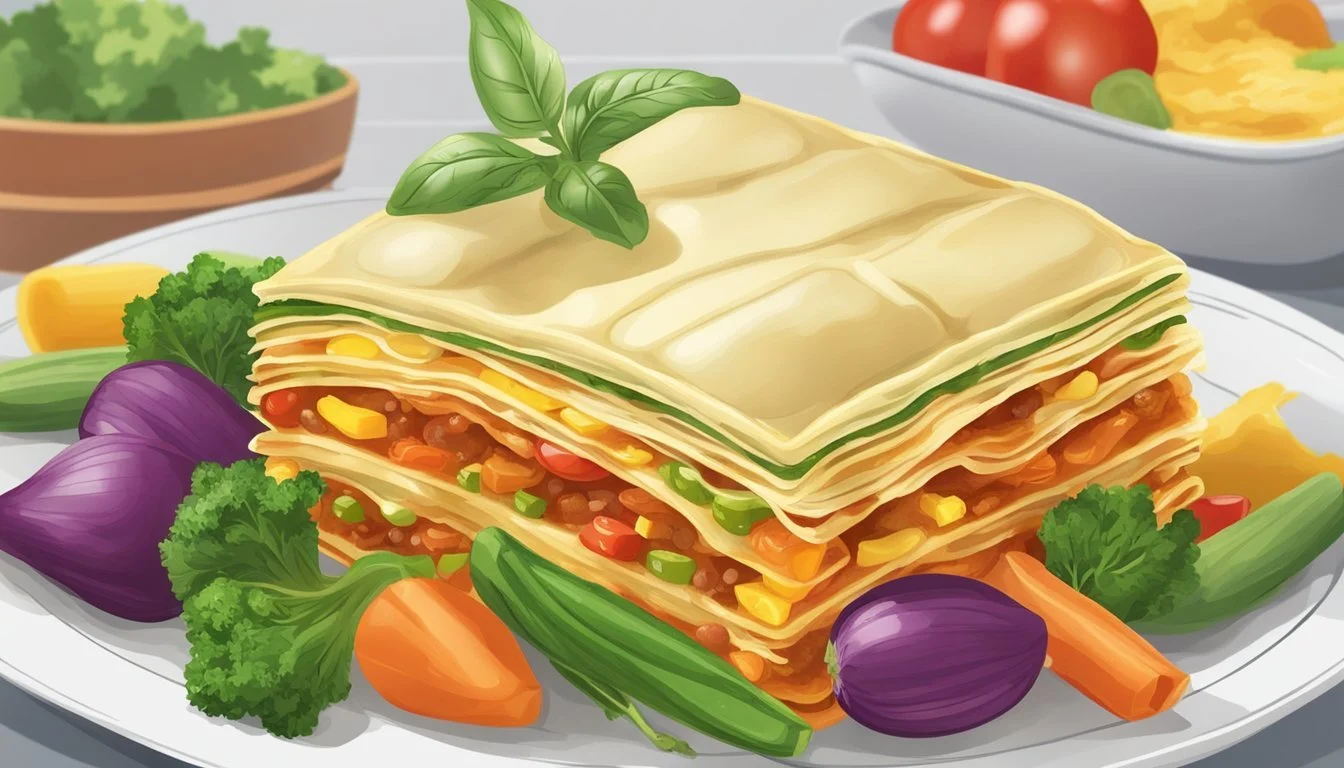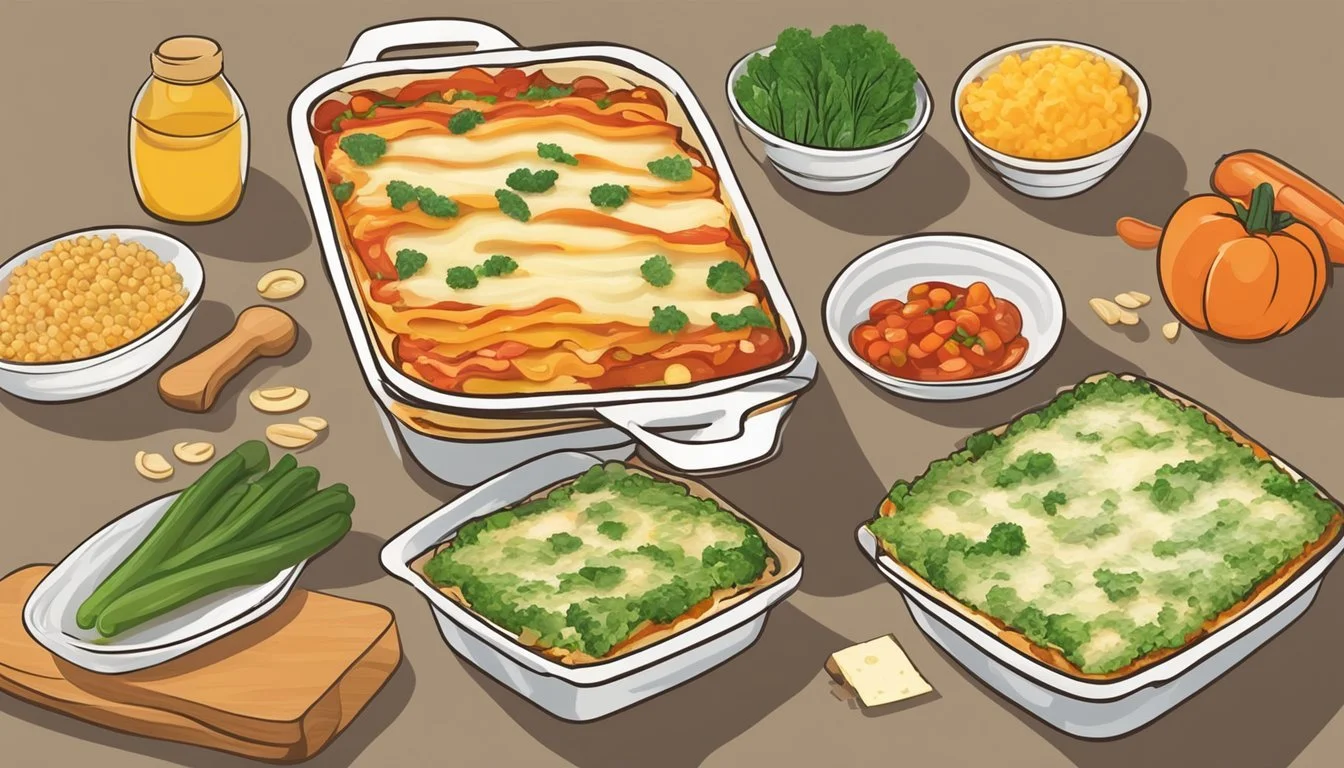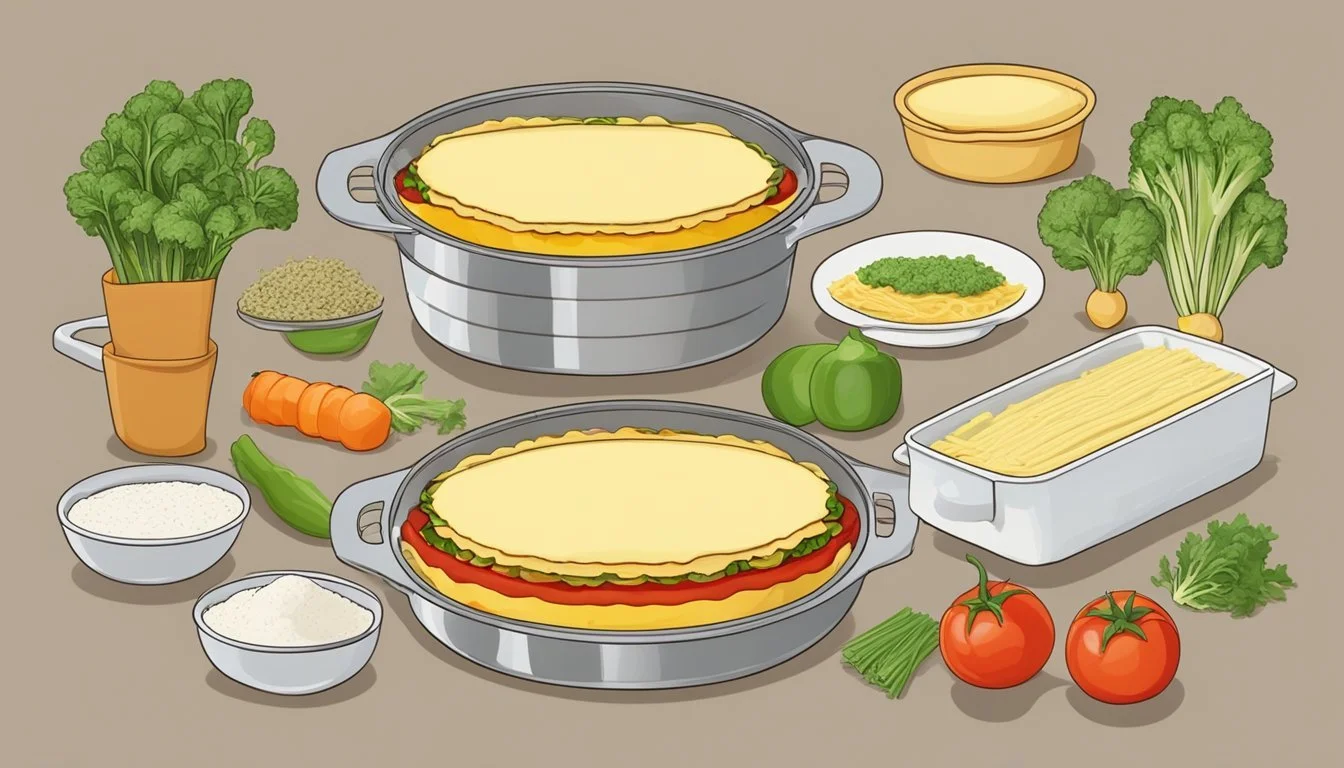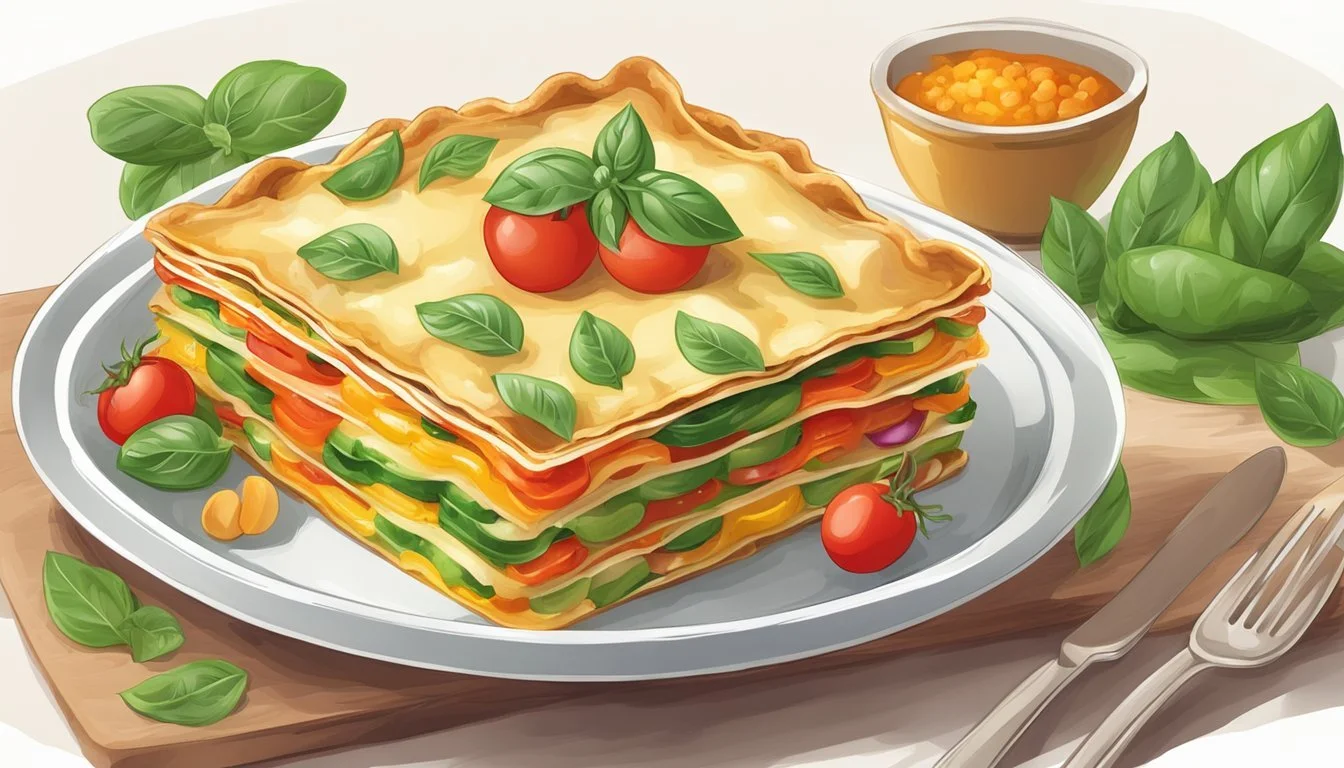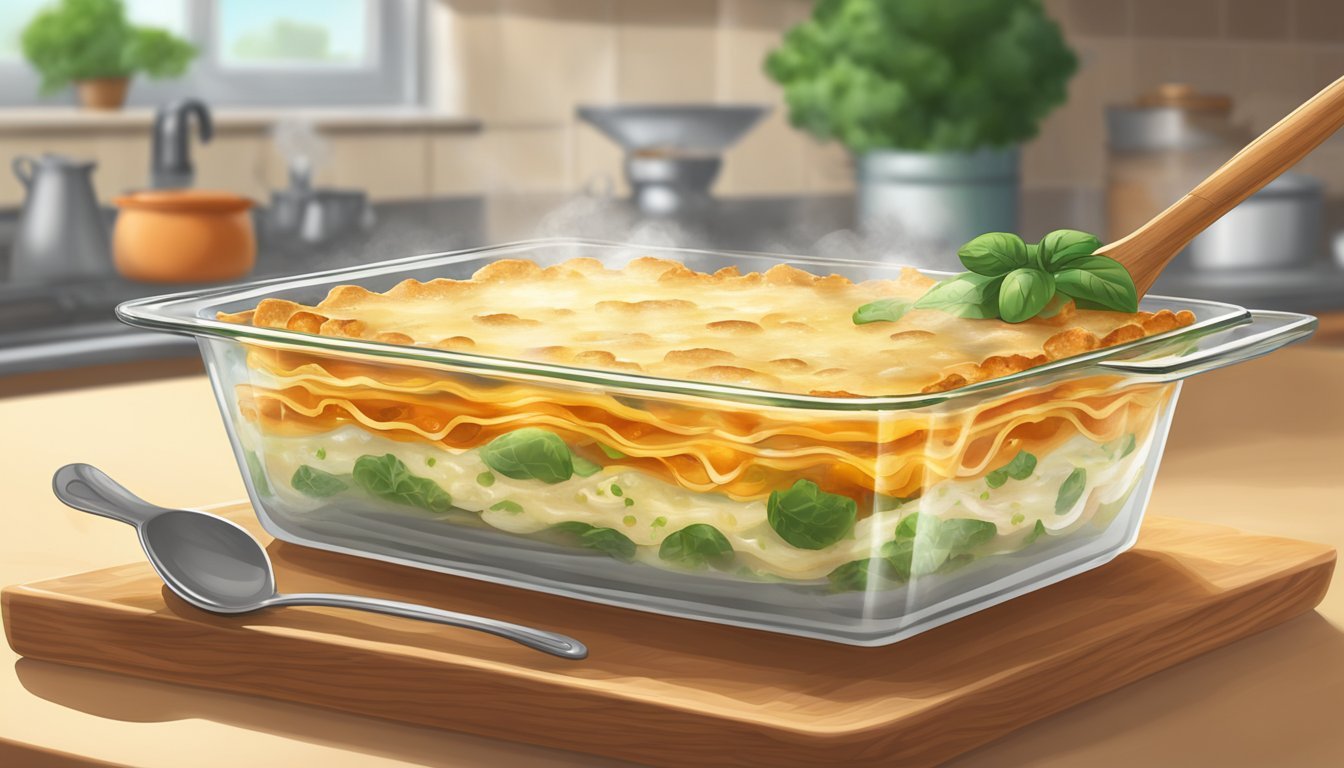How Long Does Gluten-Free Lasagna (Vegetable) Last?
Storage Tips Explained
When making a delicious gluten-free vegetable lasagna, it's essential to know how long it will last to ensure it stays fresh and safe to eat. Properly stored in an airtight container, gluten-free lasagna can last in the refrigerator for up to five days. This makes it an excellent option for meal prep, allowing you to enjoy this hearty dish throughout the week.
Freezing is also a viable option for extending the shelf life of vegetable lasagna. When appropriately wrapped and stored in the freezer, this dish can last for up to three months without compromising its flavor and texture. Simply thaw it in the refrigerator overnight when you’re ready to enjoy it.
The freshness of your lasagna will depend on the ingredients used in the recipe and how the dish is stored. Fresh vegetables, cheese, and gluten-free pasta can all influence how long your lasagna maintains its taste and quality. As always, look for signs of spoilage, such as an off smell or appearance, before consuming leftovers.
Understanding Gluten-Free Vegetable Lasagna
Gluten-free vegetable lasagna offers a nutritious alternative to traditional lasagna, featuring gluten-free noodles and a variety of vegetables. This dish caters to those with gluten sensitivities and offers numerous health benefits.
Key Ingredients for Gluten-Free Lasagna
Gluten-Free Lasagna Noodles: These form the base of the dish and can be made from rice flour, quinoa, or other gluten-free grains.
Vegetables: Typical vegetables include zucchini, carrots, and spinach. They provide texture, flavor, and essential nutrients.
Ricotta Cheese: Used for a creamy layer, ricotta adds richness and protein.
Mozzarella Cheese: This is often used to top the lasagna, providing a melty, golden finish.
Tomato Sauce: Enhances flavor and keeps the lasagna moist. Look for gluten-free varieties.
Spices: Common choices are garlic, oregano, and basil for added depth and aroma.
Health Benefits of a Vegetable Lasagna
Vegetable lasagna is rich in vitamins and minerals from the diverse array of vegetables used, including vitamins A and C, potassium, and fiber.
Protein and Calcium: Cheese like ricotta and mozzarella contributes significant protein and calcium, supporting bone health.
Lower in Calories and Fat: Compared to meat lasagna, this vegetarian version generally has fewer calories and less saturated fat.
Gluten-Free: Catering to those with celiac disease or gluten intolerance, it avoids the digestive issues linked to gluten consumption.
Antioxidant-Rich: Many vegetables included are high in antioxidants, which help fight inflammation and support overall health.
Preparing Your Gluten-Free Lasagna
When preparing gluten-free vegetable lasagna, the focus is on selecting fresh and quality ingredients, properly layering the components, and enhancing the flavor of your vegetable layer.
Selecting Quality Ingredients
Begin with high-quality, gluten-free pasta such as Barilla. Ensure that vegetables like zucchini, yellow squash, bell peppers, carrots, and baby spinach are fresh. Use ricotta or cottage cheese for the cheese mixture, and select shredded mozzarella and Pecorino Romano or Parmesan for layering.
For your tomato sauce, opt for a robust Italian variety with ingredients like garlic, onion, and oregano. Fresh herbs like basil and parsley can elevate the overall flavor profile. Utilize olive oil to sauté vegetables for added richness.
Steps for Layering Lasagna
Preheat the oven to 375 degrees Fahrenheit. Cook lasagna noodles according to package instructions if not using oven-ready ones.
Start with a thin layer of tomato sauce at the bottom of a greased 9 x 13-inch baking dish. Then, add a layer of lasagna noodles followed by a mixture of ricotta cheese, egg, salt, and pepper. Next, spread sautéed vegetables like zucchini, bell peppers, mushrooms, and spinach. Add another layer of noodles and repeat the process, finishing with mozzarella and freshly grated Parmesan.
Cover the dish with foil and bake for 55 minutes. Uncover and bake for an additional 5-7 minutes until the cheese is bubbly and golden.
Tips for a Flavorful Vegetable Layer
To create a delightful vegetable layer, sauté garlic and onion in olive oil until fragrant. Add sliced zucchini, yellow squash, mushrooms, and carrots, cooking until tender. Season with kosher salt, black pepper, and oregano.
Incorporate fresh greens like baby spinach and herbs such as basil and parsley towards the end of cooking. This keeps their flavors fresh and vibrant. For added complexity, toss in finely chopped fresh spinach and grated summer squash.
Maintaining the integrity of each vegetable ensures a balanced texture and taste in every bite of your gluten-free vegetable lasagna.
Cooking and Baking Instructions
Creating a delicious gluten-free vegetable lasagna involves a few critical steps: preheating the oven properly, setting the correct baking time and temperature, and knowing how to check for doneness. Follow these steps to ensure your lasagna turns out perfectly every time.
Proper Oven Preheating Techniques
Preheating the oven is essential. Set your oven to the required temperature before you start assembling your lasagna to ensure even cooking. For most vegetable lasagnas, preheat the oven to 375 degrees Fahrenheit (190 degrees Celsius).
A reliable oven thermometer can help you verify the correct temperature. Ensure that you place the lasagna in a fully preheated oven to avoid extending the cooking time and potentially drying out the dish.
Baking Time and Temperature Settings
The baking time and temperature for gluten-free vegetable lasagna are crucial for achieving the right texture and flavor.
For a standard recipe, bake the lasagna at 375 degrees Fahrenheit (190 degrees Celsius) for 40 to 45 minutes. Cover the baking dish with aluminum foil for the first 30 minutes to prevent the top from burning and to keep the moisture in. Remove the foil for the last 10-15 minutes to allow the cheese to melt and turn golden brown.
Checking for Doneness
To ensure your vegetable lasagna is cooked thoroughly, there are a few key indicators to watch for.
First, the noodles should be al dente—firm but not hard. Since you are using gluten-free noodles, follow the package instructions closely. Stick a fork into the lasagna to check the texture. Another sign of doneness is when you see the sauce bubbling around the edges of the baking dish.
Finally, the cheese on top should be melted and slightly browned. Let the lasagna rest for at least 10 minutes before serving to allow it to set and make cutting easier.
Following these steps will help you create a flavorful and perfectly cooked gluten-free vegetable lasagna every time.
Storing Leftover Lasagna
To ensure the best taste and safety of your gluten-free vegetable lasagna, it’s essential to store leftovers properly. This involves both refrigeration for short-term storage and freezing for long-term preservation.
Optimal Refrigeration Methods
Refrigerating lasagna correctly helps maintain its flavor and texture. Once cooled to room temperature, transfer the lasagna to an airtight container or tightly wrap it in aluminum foil.
Use within 2-3 days: For optimal quality, consume within this timeframe.
Quality may decline after 3 days: While still safe up to 5 days, texture and taste may diminish.
Store at 40°F or below: Keeping your fridge temperature consistent is crucial to prevent spoilage.
Proper refrigeration keeps the lasagna fresh, making it safe and delicious for next-day meals.
Freezing for Long-Term Storage
For extending the shelf life of gluten-free vegetable lasagna, freezing is an excellent option. Once the lasagna has cooled, it should be wrapped in multiple layers of plastic wrap, followed by a layer of aluminum foil to prevent freezer burn.
Label and date the package: This ensures you monitor how long it's stored.
Freeze in portions: If convenience is a priority, consider freezing individual portions.
Store for up to 3 months: Maintaining your freezer at 0°F ensures lasting quality.
When ready to eat, thaw the lasagna in the refrigerator overnight before reheating. This method preserves both the taste and the nutritional value of the dish.
Nutritional Information
Gluten-free vegetable lasagna provides a nutritious and balanced meal option, rich in vegetables and free from gluten. It is important to understand the calories and macronutrients involved to make informed dietary choices.
Caloric Breakdown
The caloric content of gluten-free vegetable lasagna primarily depends on the ingredients used. On average, a serving contains around 300 to 400 calories. This includes calories from vegetables, gluten-free lasagna noodles, cheese, and any added sauces.
A significant percentage of the calories come from the cheese, with approximately 100 to 150 calories per serving. The vegetables and noodles contribute the remaining calories, making the dish relatively balanced for those monitoring their caloric intake.
Macronutrient Content
Carbohydrates: Gluten-free lasagna noodles and vegetables provide the bulk of carbohydrates. A standard serving contains about 40 to 50 grams of carbohydrates. These include dietary fiber, which is beneficial for digestion and can range from 5 to 10 grams per serving.
Protein: Cheese and any added vegetables contribute to protein content. Typically, a serving offers around 10 to 15 grams of protein, which is essential for muscle repair and growth.
Fats: The fat content mainly comes from the cheese. A serving usually has 10 to 20 grams of fat, with a balance of saturated and unsaturated fats. This is crucial for a balanced diet, helping in nutrient absorption and providing energy.
Overall, gluten-free vegetable lasagna is a nutritious option, rich in fiber, moderate in calories, and well-balanced in macronutrients.
Alternative Variations
Vegetable gluten-free lasagna can be adapted in various ways to cater to different dietary preferences and needs. Some popular alternative variations include vegan-friendly substitutions, inclusion of meat for a heartier meal, and low-carb or keto-friendly options.
Vegan-Friendly Substitutes
For a vegan gluten-free lasagna, replace traditional cheese with vegan ricotta. This can be made by blending tofu, nutritional yeast, lemon juice, olive oil, and spinach in a food processor to form a thick paste.
Instead of dairy mozzarella, use dairy-free mozzarella, which melts well and provides a similar texture. You can also use cashew cream instead of cheese sauce for a rich, creamy layer. Opt for zucchini or eggplant slices instead of gluten-free noodles to add more vegetables to the dish.
Carnivorous Twists to the Classic
For those who prefer a meatier lasagna, adding ground beef or Italian sausage can enhance the flavor and make the dish more filling.
Cook the meat with onions, garlic, and Italian seasoning before layering it with gluten-free noodles, marinara sauce, and ricotta. Ground turkey or chicken can be a leaner alternative to beef, providing a different taste while keeping the lasagna hearty.
Consider incorporating vegetables like bell peppers and mushrooms alongside the meat for added texture and nutrients. These additions can make the lasagna both rich and balanced.
Low-Carb and Keto Versions
For those following a low-carb or keto diet, substitute traditional noodles with thinly sliced zucchini or eggplant. These vegetables are low in carbs and work well as noodle alternatives.
Instead of high-carb tomato sauce, use a lower-carb marinara sauce or make your own by reducing sugary ingredients. Replace standard ricotta and mozzarella with full-fat versions to fit keto guidelines.
Using a meat layer such as ground beef or sausage can further reduce carbs while maintaining flavor. Adding healthy fats like olive oil or avocado oil can also help in creating a keto-friendly lasagna without sacrificing taste.
Serving Suggestions
To elevate the gluten-free vegetable lasagna experience, pair it with complementary sides and present it appealingly. Offering flavorful accompaniments and visually pleasing garnishes can transform the dish from simple to spectacular.
Pairings and Accompaniments
When serving gluten-free vegetable lasagna as a main course, consider pairing it with side dishes that complement its flavors and textures. Garlic bread is a classic choice, with its crispness and rich garlic flavor enhancing the creamy and savory lasagna. For a lighter option, a fresh arugula salad with a tangy vinaigrette provides a refreshing contrast.
Include side dishes with varied textures to balance the meal. Roasted vegetables, such as bell peppers, zucchini, or carrots, add depth and complexity. Alternatively, a bowl of minestrone soup can pair remarkably well, providing warmth and a mix of flavors that harmonize with the lasagna.
Presentation and Garnishing
Presentation plays a crucial role in making the dish appealing. Start by plating the lasagna with clean, straight edges for a neat appearance. Use a wide spatula to serve even portions. Arrange the lasagna slice neatly on the plate, ensuring it remains intact to showcase the layers of vegetables and cheese.
Garnish the dish with fresh herbs like basil, parsley, or oregano to add a pop of color and enhance the aroma. Drizzle a bit of extra virgin olive oil on top for shine and added flavor. Adding a sprinkle of grated Parmesan cheese and a dash of red pepper flakes can also elevate the taste and presentation. Serve with the side dishes arranged thoughtfully around the main course for a balanced and inviting plate.
By focusing on pairings and garnishing, you can transform a humble gluten-free vegetable lasagna into a beautifully presented and memorable meal.
Cooking Tips and Tricks
Successful gluten-free vegetable lasagna depends on several key factors, such as mixing the ricotta cheese with the right ingredients, ensuring an ideal cheese melt, and enhancing each layer with the best combination of herbs and spices.
Making the Perfect Ricotta Cheese Mixture
To create a rich, creamy texture, blend ricotta cheese with beaten egg, grated parmesan cheese, and a bit of milk. This mixture ensures a smooth and flavorful consistency.
Adding finely chopped fresh basil or dry basil infuses the mix with aromatic notes.
Ingredients:
2 cups ricotta cheese
1 large egg
1/2 cup parmesan cheese, grated
1/4 cup milk
2 tablespoons fresh basil, chopped (or 1 tablespoon dry basil)
Combine all ingredients in a bowl and stir until well-mixed. Adjust seasoning with salt and pepper to taste.
Achieving the Ideal Cheese Melt
The key to a perfect cheese layer is using a combination of mozzarella and parmesan cheese. Mozzarella melts into a gooey layer, providing elasticity and creaminess, while parmesan adds a sharp, nutty flavor.
Sprinkle shredded mozzarella generously between layers of lasagna. Use parmesan cheese mainly on the top layer to create a crispy, golden finish. A short time uncovered in the oven ensures the mozzarella melts fully and becomes bubbly in texture.
Enhancing Layers with Herbs and Spices
Herbs and spices elevate the taste of gluten-free lasagna. Incorporate fresh basil, dry basil, and crushed red pepper between the layers. Fresh basil offers vibrant, aromatic notes, while dry basil adds subtle herbaceous flavor.
Crushed red pepper adds a hint of heat to balance out the creaminess of the cheese and the richness of the sauce. When layering, sprinkle these herbs and spices evenly over the ricotta mixture and sauce. This ensures every bite is flavorful and well-seasoned.
Incorporating these techniques ensures a satisfying gluten-free vegetable lasagna with perfect texture and well-rounded flavor.
Troubleshooting Common Issues
When preparing gluten-free vegetable lasagna, common issues like sogginess, undercooked noodles, and over-browned cheese can affect the final dish. Learning how to address these problems ensures a perfect lasagna every time.
Preventing a Soggy Lasagna
Using vegetables with high water content can cause a lasagna to become soggy. To avoid this, sauté vegetables like zucchini, mushrooms, and squash before layering. This step helps to evaporate excess moisture.
Additionally, ensure that the gluten-free lasagna noodles are cooked to a firm texture (al dente) before assembling the lasagna. If using fresh or pre-cooked noodles, ensure they are well-drained. Opt for a thick marinara sauce to prevent extra liquid in the dish. Using eggs in the ricotta mixture can also help bind and reduce moisture.
Dealing with Undercooked Noodles
Undercooked lasagna noodles can ruin the texture of the lasagna. Brown rice noodles and other gluten-free varieties often need a few more minutes of boiling compared to their wheat counterparts. Ensure the noodles are cooked until just firm before assembly.
Another method is to soak the noodles in hot water for 30 minutes if pre-cooking is not an option. This technique allows the noodles to soften just enough. If the lasagna ends up undercooked, cover the baking dish with foil and continue baking at a lower temperature until the noodles reach the desired consistency.
Fixes for Over-Browning of Cheese
While a golden top is desirable, over-browned or burnt cheese can detract from the dish. To prevent this, start by covering the lasagna with foil for the majority of the baking time. This helps to cook the lasagna without burning the top.
Remove the foil during the last 10-15 minutes of baking to allow the cheese to melt and become golden. Use shredded cheese that melts well, such as mozzarella, and avoid cheeses that brown too quickly. Monitoring the lasagna closely during the final baking stage can help achieve that perfect, bubbly top without over-browning.
By addressing these common issues, you can ensure that your gluten-free vegetable lasagna turns out perfectly every time. Adjusting cooking steps and ingredients can solve many problems, leading to a dish that is delicious and well-prepared.

